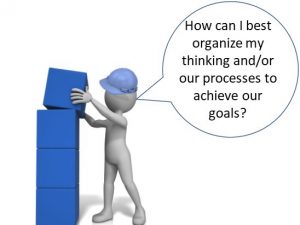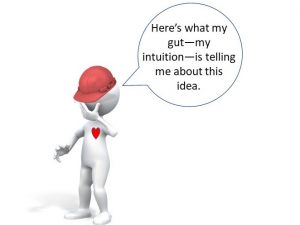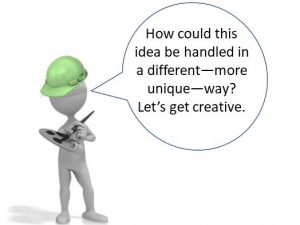Creative ideas sprout up all the time. Not all are brilliant. How can you make sure you have a “GREAT idea”?
Discipline. Research. Judgment. And a tough skin.
As creativity morphs into innovation, the focus shifts from creation to evaluation. Think differently. Here’s a tool to get you started on your great idea.
Six Thinking Hats
It’s hard for people to critique their own ideas. And people get stuck in their own habitual thinking styles. If you’re optimistic, you evaluate from that mindset. If your tendency is to be risk-averse, you approach judgment from that perspective. It takes a conscious act of will to consider an idea from multiple perspectives.
That’s where Edward de Bono’s Six Thinking Hats comes in. Similar to the sorting hats in Harry Potter (which assigned new students to one of four school House), de Bono’s hats separate questions by mindset. (Unlike the Harry Potter example, the hats don’t think; people do.)
The Six Thinking Hats system is a critical-thinking technique that “encourages” people to scrutinize something from different perspectives. It can both expand and contract the periphery of analysis.
Let me explain.
Each team member evaluates an idea “wearing” a different metaphorical hat to represent a particular thinking style; that expands the potential thought processes. It simultaneously restricts their thinking to a particular mindset; that contracts the periphery of analysis to prevent a viewpoint from being shortchanged.
Here are the colors of the six thinking hats and what they mean.
- Blue – reflective and transparent
- White – pure facts and data only
- Yellow – the sunshine of optimism and benefits
- Black – devil’s advocate
- Red – glowing passion and intuition
- Green – budding possibilities and alternatives
Blue Hat Thinker

The metaphorical role of the Blue Hat Thinker is that of an orchestrator, a skipper, a coach, a manager. A primary aim is to articulate the problem or issue being discussed and identify predefined goals. While keeping the analysis focused, the Blue Hatter must stimulate all viewpoints.
Typical statements include:
- What is the desired outcome of this process?
- Do we understand the “big picture” of the product or idea being studied?
- How can the team handle all the expressed ideas, facts, and opinions evenly?
- Let’s stay on track.
White Hat Thinker

The White Hat Thinker is neutral, expressing facts and data without opinion. A primary aim is to collect and disseminate all data, statistics, and information relevant to the topic being studied. While prioritizing facts over opinions, the White Hatter provides solutions, along with gaps in knowledge.
Typical statements include:
- What is everything we now know about the problem and the solutions represented by this idea?
- What don’t we know?
- How can we acquire more information?
- Here is the estimated cost per unit.
Yellow Hat Thinker

The Yellow Hat Thinker is optimistic, focused on making a great idea work. A primary aim is to offer a greater stockpile of solutions and opportunities. While searching for new benefits, the Yellow Hatter makes plans that embody optimism and determination.
Typical statements include:
- How can we realistically make this work?
- What other logical benefits exist?
- Can we bridge long-term and short-term opportunities?
- Our sales staff has had success with similar offerings.
Black Hat Thinker

The Black Hat Thinker takes on the role of devil’s advocate, identifying risks, pitfalls and dangers. A primary aim is to shine a light on (and eliminate) weaknesses and shortcomings. While exposing dangers and flaws, the Black Hatter must avoid bringing negative biases into the critique process.
Typical statements include:
- In what ways might this idea fail?
- What flaws might prove fatal to commercialization?
- The financial return on this project is not acceptable.
- We don’t have the capacity to follow through on this.
Red Hat Thinker

The Red Hat Thinker deals with feelings, emotions, hunches, and intuition. A primary aim is to uncover subconscious emotional tendencies. While conveying personal emotions and gut instinct, the Red Hatter speaks from the heart as a counter measure to pure data.
Typical statements include:
- I really love (hate) this project.
- My gut is telling me we’re missing something in the solution.
- Based on my feelings, I think this change would be a better way to go.
- That last suggestion makes me anxious.
Green Hat Thinker

The Green Hat Thinker brings a sense of creativity and open reflection on novel alternatives. A primary aim is to expand possibilities to unexpected solutions. While opening the door to free-flowing creativity, the Green Hatter may sometimes bring up ideas that seem wacky at first.
Typical statements include:
- What other alternatives exist?
- Let’s brainstorm some different approaches to that obstacle.
- How can we get more provocative and less conservative in our ideas?
- What if…?
Commercialization Checklist
To commercialize an idea (i.e., turn it into a saleable product or service), it must embody several features. While the Six Thinking Hats can help evaluate and refine creative concepts, you still want to ensure the idea passes a commercialization checklist.
First, there has to be a sufficiently large market. Are there enough customers (companies or consumers) to justify moving forward?
Second, the concept has to be better than the competition in one or more areas that offer relevant value to target prospects. Generic value alone is insufficient.
Third, the prospective product has to provide a profitable opportunity. Unless the forecasted revenues (price times quantity) exceed all related costs, you need to refine, table, or kill the idea.
And finally, the idea has to be REAL; building and producing it must be possible within the time-frame allotted.
